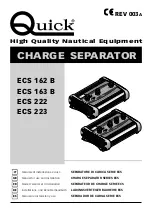
User Manual - Ground Mount Solar Hot Water System - August 2017
4
Handy Hints about Boosting
The following hints are provided to assist you with your operation of your solar water heater:
1.
Solar energy input is greater on sunny days between 10am and 3pm. If possible, schedule your large hot water
demands (e.g. heavy washing or laundry) for as close as possible to the middle of the day.
2.
If a timer is installed, boost your tank’s water after this 10am to 3pm hot period. The sun has made its maxi
-
mum contribution by this time, the booster will then raise the water to the desired temperature if the sun has
not done so (in winter for example).
3. Keep trees in the sun’s path at a level where the collectors are not shaded at any time during
periods of effective solar radiation.
OFF PEAK ELECTRICITY & BOOSTING
If the water heater’s in-tank electric booster is connected to an Off Peak (night rate) electrical supply, it is
important to remember that the booster may only operate late at night. On cloudy days the tank may only gain a
small amount of energy during the day. Careful planning will be required to avoid running out of hot water if large
quantities are drawn during the day. In areas where a Day Rate electrical switch is permitted, the storage tank can
be boosted to ensure hot water is available at the end of the day.
Solargain Hot Water Performance & Operation Information
General facts to know about your Solargain Water Heater
The performance and energy savings that you can expect from your Solargain water heater will depend upon a
number of factors, such as water usage patterns, daily temperatures, available solar energy and the cost and type
of purchased energy being utilized.
Solargain active open loop split system
Our solar collector is a thermal solar heating device, quite different to photo-voltaic ”PV” which converts the sun’s
energy into electricity. The Solargain process is very simple:
1. The collector on your roof absorbs sunlight and converts it into usable heat
2. An electronic controller measures the temperature of the solar collector and the water in the bottom of the
storage tank. If the collector is hotter, meaning there is heat available, the controller supplies power to a
circulation pump which pushes water through the collector and back to the storage tank.
3. Throughout the day the circulation pump switches on and off gradually heating up the water in the tank. This
is called solar contribution.
Understanding Solar Contribution
Some solar hot water owners make the mistake of thinking that once they install a solar water heater they can turn
their element or gas booster off whenever there is sunlight. This is incorrect for two reasons:
Firstly it is a requirement to heat the water to 60
o
C on a regular basis to kill Legionella bacteria.
Secondly, solar radiation is only half or one third as strong in the winter months compared to summer, and
therefore is not able to provide the same amount of hot water as in the summer. Your solar system is designed to
meet virtually 100% of summer hot water needs and will provide about 50% in the winter, averaging about 60-80%
annually, depending on your location.
If the solar contribution during the day is not enough to raise the water to a suitable temperature an electric or gas
booster will be required to provide additional heating.




























